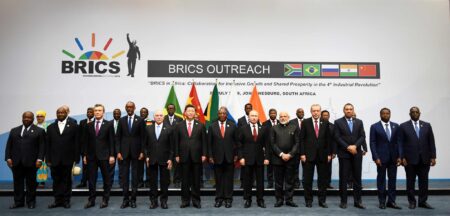The modern world’s engine runs on crude oil, producing more than 10 million barrels daily. Saudi Arabia is the world’s biggest single oil producer.
Slightly bending to the weight of global calls against the soaring oil prices, as of last month (August 2022), the world’s major oil exporters, who together form OPEC, a group of 23 oil-exporting countries, agreed to increase their production this September.
Should they live up to their promise, increased production will lower oil prices and the cost of living in each country.
- OPEC to increase oil output to stabilize prices
- The US is pushing to maintain output supremacy
- Africa’s oil output is not enough to affect global prices
In July, these ‘oil monopolies’ agreed to increase oil production by 600,000 barrels a day (July-August). Still, after the continued outcry, the agreement is that the members of OPEC, including Russia, will jointly increase output by 100,000 barrels a day.
Read: Oil price drop should nudge Africa towards clean energy
As you read this article, the OPEC nations produce around 30% of the world’s crude oil, which is an estimated 28 million barrels a day. This new agreement is that the members of OPEC will jointly increase output by 100,000 barrels a day.
That said, Riyadh is pushing for more cuts in crude oil production, but its recent ‘partner’ in the bid, Moscow, is waiting for Washington to take a greater blow from the plummeting prices before it lowers output.
Lowering oil output would stabilize prices, re-strengthen US shale producers, and Moscow does not want to see that happen. So, it is flooding the market with oil to keep prices down and eventually suffocate the US shale dealers.
The US has been the world’s leading oil producer since it struck the mother load in 2012 and doubled its oil production to 12 million bpd. Moscow-led OPEC and Saudi Arabia have been fighting to compete with it, or shall we say, to limit its control of global oil prices.
Only last December, the OPEC (and partners) coalition agreed to chop oil output by 1.7 million bpd, and in turn, Saudi Arabia agreed to cut its output by 400,000 bpd. However, Moscow is now backing away from more cuts in production because reducing production would give breathing room to the already suffering US producers.
The US remains unmoved. It refuses to lower output despite the falling oil prices that have seen Washington suffer a minus US$4 in oil futures. Meanwhile, the Kremlin’s response has been to flood the market with even more oil output to push prices down.
While US oil producers have previously proved to be rather resilient to low prices, managing to counterbalance prices as low as US$30 per barrel in the past (see details below), they may not fare so well this time around.
The shale producers were already suffering over the last year as Moscow waged an outright oil price war on them, persistently flooding the market to keep prices down. Needing prices to stay at US$65 per barrel to at least break even, let alone sniff a profit, many US producers filed for bankruptcy.
These ongoing falls in prices will only serve to crash them. News reports place the number of oil producers filing for bankruptcy at 208 over the last five years alone; more than 40 companies have filed for bankruptcy yearly since 2015.
To put it into perspective, this means that for the last five years, three oil-producing companies in North America have been forced to file for bankruptcy every month. That is almost one company every other week!
This raises the question: how will the US fare at the end of this oil price debacle? How many US shale oil producers will still be operational when it all ends? Will and can Washington, as it did with the banks in the 2008 global economic crisis, bail out its oil producers? Can it shield them from the free-falling prices?

Riyadh parting ways with Moscow?
The US is not alone in its price dilemma. On the other hand, Saudi Arabia, whose production cost is also rather high, is making Riyadh very concerned with the falling prices. After all, Saudi Arabia is the world’s top oil exporter. With Russia maintaining output despite Saudi Arabia and the OPEC members asking for further cuts, it is safe to ask whether Moscow and Riyadh have reached a crossroads and may part ways.
Read: Saudi Arabia to explore oil industry opportunities in Tanzania
While Russia can withstand lower oil prices because it can survive at about US$50 per barrel, Saudi Arabia which needs no less than US$80 per barrel, cannot stand any further fall in prices.
Learning from past mistakes, Saudi Arabia, which once pushed oil prices down to US$30 a barrel attempting to box out US shale producers, only ended up suffering worse than its target, and so Riyadh would rather not play that game this time around.
Instead, Saudi Arabia wants to play it safe, proposing an additional one million bpd in its attempt to stabilize prices. However, it is facing two issues. One, the market is already saturated with oil such that even more cuts will do little to float the price and second, which may well be the source of reason number one, is that the market seems more concerned with the global health issue than the price of oil.
The question that begs to be asked is, where is China, the world’s largest oil importer in all of this? Beijing is certainly right in the middle of this rather gruesome picture. How could it not? After all, it is the world’s largest oil consumer, gobbling up 13 of every 100 barrels of oil produced.
China buys almost 70 per cent of the oil OPEC and members produce annually. Still, China’s demand, following the coronavirus outbreak, has fallen by 20 per cent, almost a quarter of its previous demand.
Understandably so, because most factories and manufacturing operations in China had to be closed to control the virus’s spread. As a result, all major refineries in China have since reduced the processing of crude oil down to as low as 40 per cent.
So, demand is at an all-time low; product reserves are high, and it looks like prices will continue to fall. Therefore, who will survive the oil price war?











